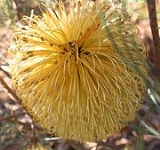
Banksia sphaerocarpa var. dolichostyla
Encyclopedia
Banksia sphaerocarpa var. dolichostyla, commonly known as Ironcap Banksia, is a plant which is either considered a variety of Banksia sphaerocarpa
, or as a species in its own right. It is native to the Southwest Botanical Province of Western Australia
. Seeds do not require any treatment, and take around 33 days to germinate.
s appear in autumn, larger and more elongate than spherical as with the other forms of B. sphaerocarpa. It derives its name from its 50–65 mm long pistils, the longest of any banksia, and perianth (49-55mm). The grey old flowers remain on the old cones.
in 1978, it was officially described in the 1981 revision of the genus Banksia as a variety of Banksia sphaerocarpa. The specific epithet was derived from the Ancient Greek
words dolichos "long" and stylos "pillar", in reference to the long styles.
Botanist and plant taxonomist Kevin Thiele
analysed the morphometrics in his cladistic paper of 1996, and announced that the Ironcap banksia warranted specific status. He analysed Banksia micrantha
as the sister group to the pair of B. sphaerocarpa var sphaerocarpa and B. sphaerocarpa var caesia, and noted that the Ironcap banksia, which was a sister taxon to this combined group, had stouter old styles on old cones which did not curl around, while those of the other varieties curled around the infructescence to form a ball.
George replied in the 1999 Flora of Australia treatment of Banksia that he did not feel this character alone justified specific rank, and that otherwise the plant was merely larger in all parts to var. caesia but essentially similar.
In 2002, Mast’s molecular study yielded a surprise when molecular analysis mapped out the Ironcap banksia as a sister taxon to its geographical neighbour B. violacea in a larger group together with B. laricina and B. incana. Banksia micrantha and the two remaining sphaerocarpa varieties form a related group.
Banksia sphaerocarpa
Banksia sphaerocarpa, commonly known as the Fox Banksia or Round-fruit Banksia, is a species of shrub or tree in the plant genus Banksia . It is generally encountered as a 1–2 m high shrub, and is usually smaller in the north of its range...
, or as a species in its own right. It is native to the Southwest Botanical Province of Western Australia
Western Australia
Western Australia is a state of Australia, occupying the entire western third of the Australian continent. It is bounded by the Indian Ocean to the north and west, the Great Australian Bight and Indian Ocean to the south, the Northern Territory to the north-east and South Australia to the south-east...
. Seeds do not require any treatment, and take around 33 days to germinate.
Description
The Ironcap Banksia is an open, spreading, woody shrub some 3–4 m (9.8–13.1 ) high by up to 4 m (13.1 ft) wide. The foliage is glaucous (pale blue-grey), with bright green new growth. The roundish to elongated golden-yellow inflorescenceInflorescence
An inflorescence is a group or cluster of flowers arranged on a stem that is composed of a main branch or a complicated arrangement of branches. Strictly, it is the part of the shoot of seed plants where flowers are formed and which is accordingly modified...
s appear in autumn, larger and more elongate than spherical as with the other forms of B. sphaerocarpa. It derives its name from its 50–65 mm long pistils, the longest of any banksia, and perianth (49-55mm). The grey old flowers remain on the old cones.
Taxonomy
First collected by botanist Alex GeorgeAlex George
Alexander Segger George is a Western Australian botanist. He is the authority on the plant genera Banksia and Dryandra...
in 1978, it was officially described in the 1981 revision of the genus Banksia as a variety of Banksia sphaerocarpa. The specific epithet was derived from the Ancient Greek
Ancient Greek
Ancient Greek is the stage of the Greek language in the periods spanning the times c. 9th–6th centuries BC, , c. 5th–4th centuries BC , and the c. 3rd century BC – 6th century AD of ancient Greece and the ancient world; being predated in the 2nd millennium BC by Mycenaean Greek...
words dolichos "long" and stylos "pillar", in reference to the long styles.
Botanist and plant taxonomist Kevin Thiele
Kevin Thiele
Kevin R. Thiele is curator of the Western Australian Herbarium. His research interests include the systematics of the plant families Proteaceae, Rhamnaceae and Violaceae, and the conservation ecology of grassy woodland ecosystems...
analysed the morphometrics in his cladistic paper of 1996, and announced that the Ironcap banksia warranted specific status. He analysed Banksia micrantha
Banksia micrantha
Banksia micrantha is a species of shrub in the plant genus Banksia. A small spreading bush with pale yellow flower spikes, it occurs between Eneabba and Cervantes in South west Western Australia...
as the sister group to the pair of B. sphaerocarpa var sphaerocarpa and B. sphaerocarpa var caesia, and noted that the Ironcap banksia, which was a sister taxon to this combined group, had stouter old styles on old cones which did not curl around, while those of the other varieties curled around the infructescence to form a ball.
George replied in the 1999 Flora of Australia treatment of Banksia that he did not feel this character alone justified specific rank, and that otherwise the plant was merely larger in all parts to var. caesia but essentially similar.
In 2002, Mast’s molecular study yielded a surprise when molecular analysis mapped out the Ironcap banksia as a sister taxon to its geographical neighbour B. violacea in a larger group together with B. laricina and B. incana. Banksia micrantha and the two remaining sphaerocarpa varieties form a related group.

